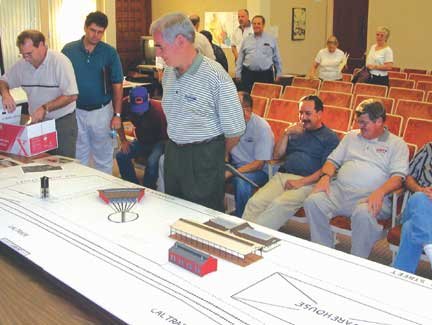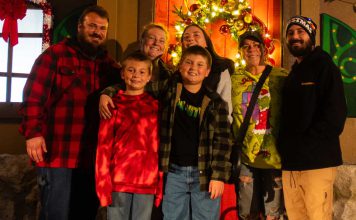GILROY
– The transportation guru who wants to bring a train museum to
Gilroy is having trouble convincing a cautious City Council that
its downtown won’t become a dumping ground for 3,000 tons of iron
and metal the county no longer wants.
After a one-hour, face-to-face meeting this week with railroad
aficionado and former county supervisor Rod Diridon, Council
members still don’t have the answers they need to lead an all-out
effort to land the potential tourism draw.
GILROY – The transportation guru who wants to bring a train museum to Gilroy is having trouble convincing a cautious City Council that its downtown won’t become a dumping ground for 3,000 tons of iron and metal the county no longer wants.
After a one-hour, face-to-face meeting this week with railroad aficionado and former county supervisor Rod Diridon, Council members still don’t have the answers they need to lead an all-out effort to land the potential tourism draw. Council decided the city’s business arm – the Gilroy Economic Development Corporation – should do the legwork that could help bring the historic railroad museum to Gilroy.
The two biggest issues Council wants resolved:
• Convincing landowner Union Pacific to donate roughly a fourth of its parcel along the railroad tracks between Old Gilroy and Ninth streets.
• Guaranteeing the work will be completed within a reasonable time frame so the lot does not remain a construction yard as the rest of downtown gets revitalized.
“I had many concerns going into the meeting, and for the most part they’re still there,” Councilman Roland Velasco said. “I think we need a healthy dose of skepticism when dealing with this project.”
Council directed City Administrator Jay Baksa and GEDC Executive Director Bill Lindsteadt to work with Diridon on a step-by-step plan and time line for bringing the museum to Gilroy.
Lindsteadt said he hopes to have a plan ready for Council approval by the end of October. After that, he would approach Union Pacific to see if they are willing to donate a portion of a 12-acre downtown site to be used for the museum.
The site is located between Old Gilroy and Ninth streets to the north and south and Alexander Street and the railroad tracks to the east and west. The artifacts are currently at the county fairgrounds in San Jose and must be moved by Nov. 1. Diridon said he may get the county to relax the deadline if he can find a city that will develop the museum with him.
If Diridon, former chairman of the Valley Transportation Authority, cannot find a willing city, the materials would likely go to existing railroad museums in California and other states, he said. However, San Jose and Santa Clara have also been courting Diridon.
Diridon, who showed up at Monday’s meeting with a scale model of his train museum, has called Gilroy the “ideal” location for the facility since the available land here can access Caltrain tracks. Track access is important because the museum would take the historic locomotive to special locations and pull trains to San Francisco and eventually Monterey.
Blight plight
Although downtown revitalization activists are coveting the opportunity to land the potential tourism draw, City Council turned skeptical earlier this month. Velasco, a policy advisor to Santa Clara County Supervisor Don Gage, warned fellow Council members that Diridon is making his museum plans based on funding grants that have not yet been won and volunteer contractors who rarely stick to firm work schedules.
Earlier this month, Velasco produced county documents describing the fairgrounds as being in a blighted condition since the train artifacts, roughly 3,000 rusting tons of them, are being stored there.
Diridon steadfastly rebutted the blight argument. He said the area would be fenced in for security and the materials would be stacked in an orderly fashion.
“It isn’t going to look like a junkyard,” Diridon said.
Velasco was not convinced.
“Putting a fence around 3,000 tons of metal would be fine if you know the project has a definite start and end time. But at present, Rod (Diridon) has no plan because he’s depending on volunteers to get the work done.”
Diridon said he has 50 volunteers signed on to the massive refurbishing project that would erect a railroad roundhouse, turntable, water tower and herder shack in the first phase of construction. He stopped short, however, of saying he would fulfill a hard deadline and is insisting to do the work piecemeal and under no formal time constraints.
Diridon said he would develop the museum elsewhere if he is forced to put workers on a strict timeline.
“There’s no question we’ll get it done. We just can’t be on the strict (time line) you would be on with a commercial contractor,” Diridon said. “From the point we have your permission to move onto the site, it will probably take a couple years after that,” Diridon said. “It will go pretty fast with the volunteers, but they are volunteers. If you want to pay them full price, we can get it done real fast.”
Velasco says Diridon should at least produce the list of contractors to help quell concerns the project may start but never stop.
Funding
Diridon admits his California Trolley and Railroad Corporation does not have the money to buy the land for the museum or fund its construction. However, he said it was not a lost grant or poor planning that caused the fairgrounds project to stay grounded.
Rather, it was the county’s insistence that the volunteer contractors use their bonding capacity to ensure the work gets done on time. Bonding is when a contractor promises to finish a job by a certain time or pay for the work to be done by someone else.
Diridon said volunteer efforts usually don’t require bonding because after a certain amount of bonding, contractors are capped off from issuing more.
“You’re not going to get contractors to do work for free because they won’t be able to take paying jobs,” Diridon said.
One aspect of the project that will be funded is moving the artifacts from the fairgrounds to its ultimate destination. According to Diridon, the county will pay the transportation costs.
Union Pacific
The city will need to find a way to convince Union Pacific railroad to donate a portion of its 12-acre site between Old Gilroy and Ninth streets to Diridon’s museum effort.
Diridon estimated the land there to be worth $250,000 to $500,000 an acre.
Diridon asked the city Monday to eventually grant preferential zoning to Union Pacific if it makes the donation, allowing the company to develop the remaining property in whatever manner it wants, pending city approval.
“The possibilities are limitless,” Diridon said. “You make them so aware that they’d get an advantage on the land they have left that they’d be willing to give up this portion.
Design
Diridon, who has a San Jose train station named after him, said the museum would be developed in two phases. The first phase would refurbish the artifacts and begin train excursions. A second development phase would revolve around construction of a more traditional museum building that would house artifacts and other displays.
Once the buildings are reconstructed, trains would be brought to Gilroy and eventually the museum would be open to the public for tours. Among the trains Diridon would bring to the site are a 1924 steam locomotive, a 1941 diesel locomotive and passenger cars.
“In San Jose … we’d be one special event location out of 30. In Gilroy, we’d probably be ‘the’ special event location in the city,” Diridon said.













